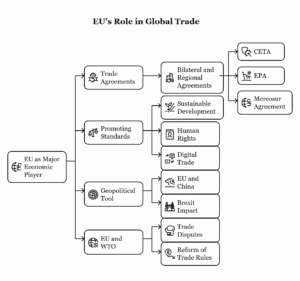-
Continue reading →: Constitutional safeguards for the protection of minorities in Canada
The protection of minority rights is a fundamental principle in Canadian democracy, enshrined within the country’s constitution and legal framework. Canada has a long-standing commitment to upholding the rights of its diverse populations, including linguistic, cultural, religious, and ethnic minorities. These constitutional safeguards are primarily found in the Canadian Constitution,…
-
Continue reading →: Quebec nationalism
Quebec nationalism refers to the political and cultural movement that seeks to promote the distinct identity, culture, and autonomy of the province of Quebec, a French-speaking region within Canada. This movement has been a significant and sometimes contentious part of Canadian politics, particularly since the 1960s. Quebec nationalism encompasses a…
-
Continue reading →: Role of civil society organizations in the functioning of Canadian democracy
Civil society organizations (CSOs) play a crucial role in the functioning of Canadian democracy by promoting citizen participation, advocating for human rights, and ensuring government accountability. These organizations, which range from grassroots movements to well-established non-governmental organizations (NGOs), form an essential part of Canada’s democratic fabric. They contribute to public…
-
Continue reading →: Features of environmental movements in Canada
Environmental movements in Canada have played a crucial role in shaping the country’s environmental policies and contributing to global environmental discussions. These movements have evolved over several decades, driven by growing concerns about environmental degradation, climate change, pollution, and the sustainable use of natural resources. Canada’s vast natural landscapes, rich…
-
Continue reading →: Critically assess the role of pressure groups in Canada
Pressure groups, also known as interest groups or advocacy groups, play a crucial role in the democratic process of Canada. These groups seek to influence public policy, government decisions, and public opinion on a wide range of issues, from environmental protection to workers’ rights, to industry regulations. The role of…
-
Continue reading →: Main features of administrative reforms in Canada during the 1980s and 1990s.
The 1980s and 1990s were transformative decades for Canada’s administrative system, marked by a series of significant reforms aimed at improving the efficiency, accountability, and responsiveness of the federal government. These reforms were driven by the need to address rising public dissatisfaction with government performance, fiscal constraints, and the changing…
-
Continue reading →: Judicial system in Canada
The judicial system in Canada is a cornerstone of the country’s democratic and constitutional framework, ensuring the rule of law, protecting individual rights, and maintaining a balance of power between the various branches of government. Canada’s judiciary operates within a federal system, which means that both provincial and federal courts…
-
Continue reading →: Main features of federalism in Canada
Canada’s federal system of government is a key characteristic of its political structure, designed to manage the diverse geographical, cultural, and linguistic divisions within the country. Federalism in Canada is distinct from other systems due to its unique historical context and constitutional evolution. It allows for the division of powers…
-
Continue reading →: process of evolution of the Canadian economy from largely rural to an industrial one
The evolution of the Canadian economy from a largely rural, agrarian society to an industrialized one is a story that reflects broader shifts in the global economy and the impact of technological advancements, economic policies, and international trade. This transformation occurred primarily between the late 19th and early 20th centuries,…
-
Continue reading →: Impact of Reforms on the Canadian Federal System in the Context of Local Self-Government
Canada’s federal system, which divides powers between the central government and provincial or territorial governments, has undergone significant reforms over the years. These reforms have impacted local self-government by shifting power dynamics, enhancing the autonomy of provinces and territories, and addressing demands for greater political and administrative decentralization. The evolution…
-
Continue reading →: Nature and Role of NGOs in Social Movements in Canada
Non-Governmental Organizations (NGOs) in Canada play a crucial role in addressing social issues, advocating for the marginalized, and driving change in various sectors. Their involvement in social movements has been significant, with NGOs acting as catalysts for social, political, and environmental reforms. These organizations, which operate independently from the government,…
-
Continue reading →: Programme and Social Basis of Liberal and Progressive Conservative Parties
The Liberal Party and the Progressive Conservative Party are two of Canada’s major political parties, each with a distinct political and social base. These parties have played pivotal roles in shaping Canada’s political landscape, and understanding their programs and social bases provides insight into their ideological positions and the broader…
WELCOME!
Yearly Archive
Categories List
- biodiversity
- Canada
- culture
- democracy
- economy
- European Union
- ignou
- india
- International Relations
- nature
- news
- political-philosophy
- political-science
- sustainability
- Uncategorized
- UPSC
Tag Cloud
agriculture ai business Canada china climate climate-change conservation diversity ethics european-union farming feminism finance gandhi health history ignou india KNOWLEDGE liberty mahatma-gandhi marxism nationalism nonviolence philosophy political-philosophy political-science political-theory politics poverty PSC religion renewable-energy russia socialism sociology sustainability sustainable-agriculture sustainable-living technology terrorism travel UPSC women
Term List
- africa
- agriculture
- ai
- aristotle
- bangladesh
- bjp
- business
- Canada
- china
- christianity
- climate
- climate-change
- conservation
- critical-theory
- digital-marketing
- diversity
- ecology
- elections
- ethics
- europe
- european-union
- faith
- farming
- fascism
- featured
- feminism
- feminist
- finance
- frankfurt-school
- freedom
- fundamentalism
- gandh
- gandhi
- gardening
- gender
- gender-equality
- global-warming
- government
- health
- herbs
- history
- human-rights
- ignou
- india
- inequality
- intellectual-property
- italy
- karl-marx
- KNOWLEDGE
- language
- law
- learning
- lenin
- liberty
- lifestyle
- linguistics
- mahatma-gandhi
- marx
- marxism
- mental-health
- MPS
- multicultural
- multiculturalism
- nationalism
- natural-remedies
- nonviolence
- organic-farming
- patents
- philosophy
- political-philosophy
- political-science
- political-theory
- politics
- pollution
- poverty
- PSC
- recycling
- religion
- renewable-energy
- russia
- socialism
- sociology
- soviet-union
- spirituality
- sustainability
- sustainable-agriculture
- sustainable-living
- teaching
- technology
- terrorism
- trademarks
- travel
- UPSC
- water
- water-conservation
- wellness
- wildlife
- women
- women-empowerment





